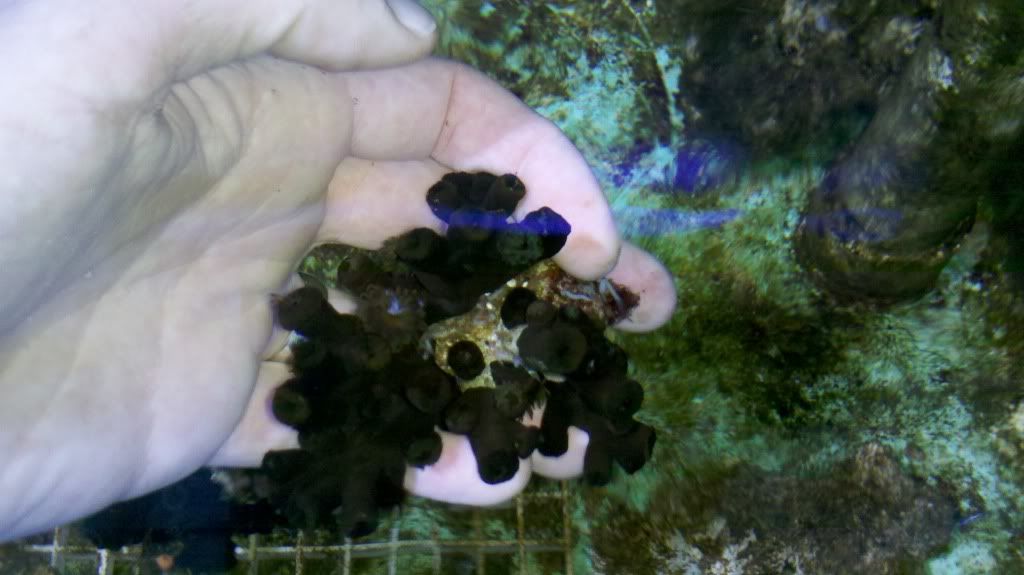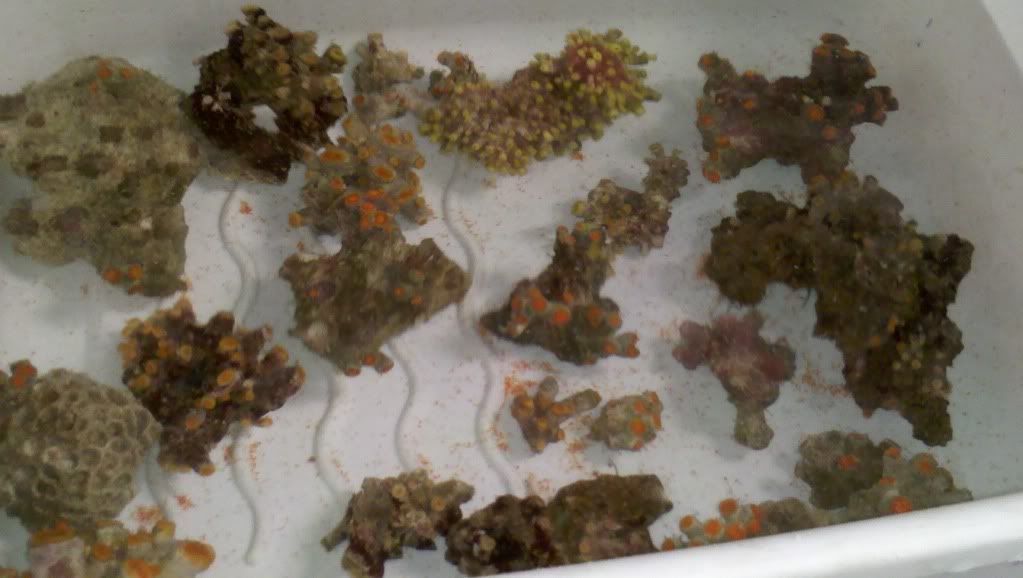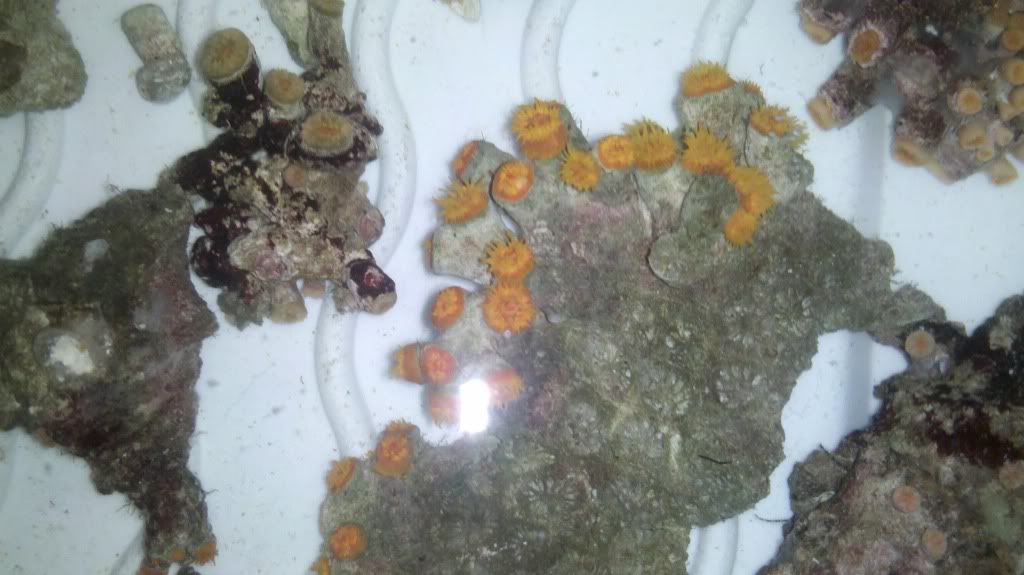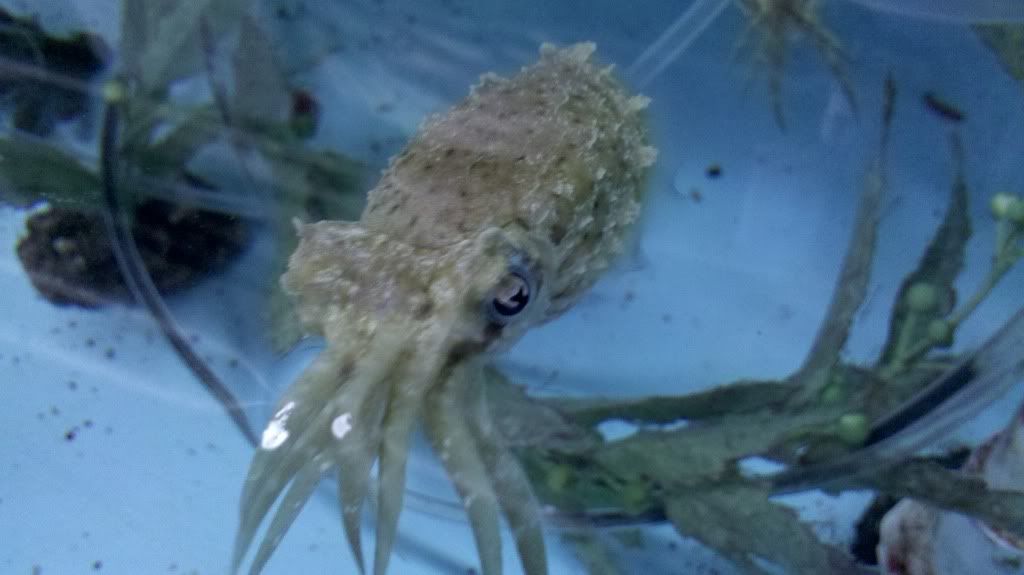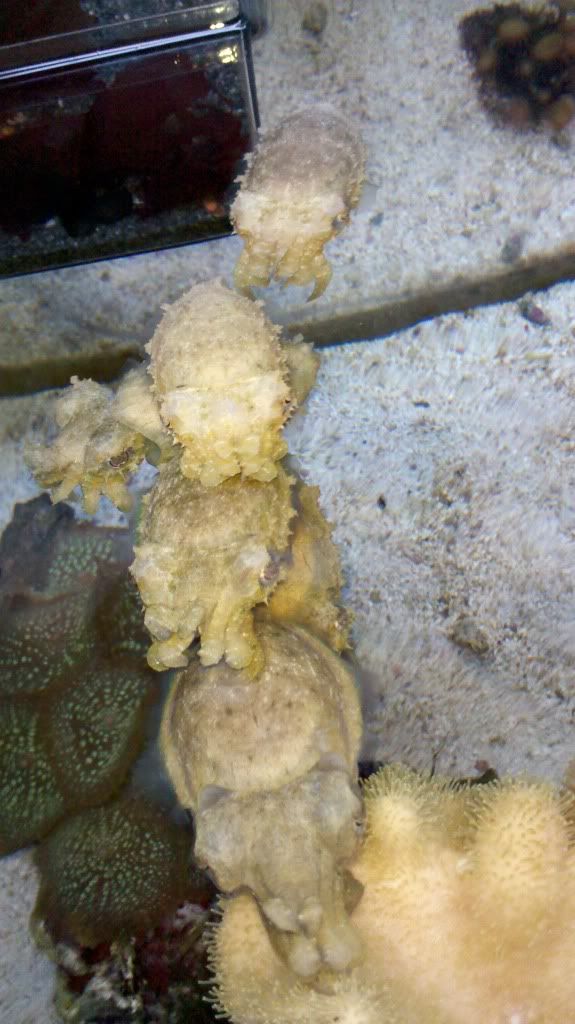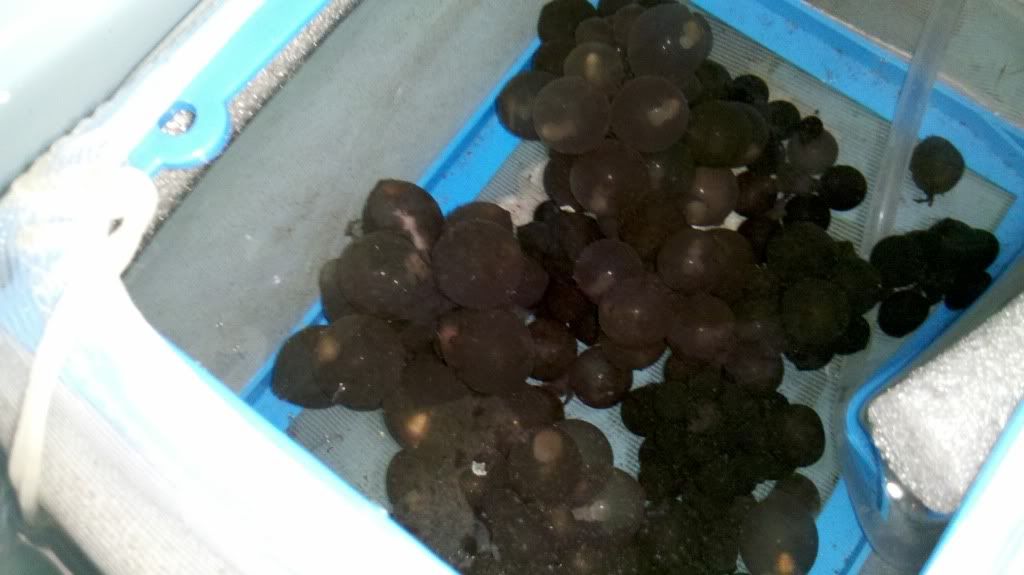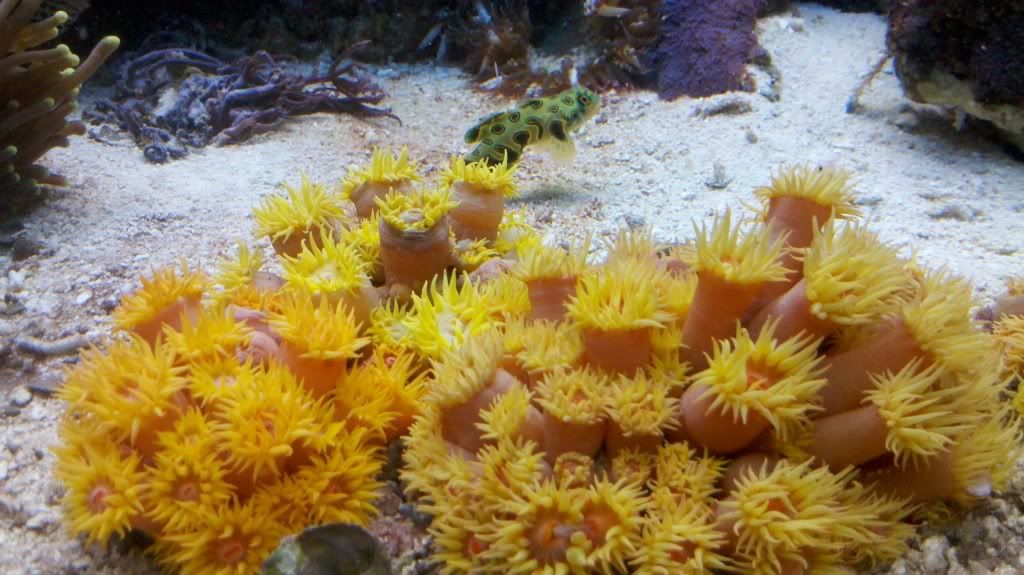 |
| Sun Coral colonies in the author's aquarium. |
Keeping Tubastrea spp. - The Sun Corals
Introduction
I remember the day I saw the radiant glory of my first colony of Yellow Sun Coral at my favorite LFS. It was the same day I bought my first colony of Yellow Sun Coral and I really didn't understand what I was getting myself into. Luckily, Cy, the owner, had the knowledge and integrity to explain to me that this coral species was azooxanthellate and needed to be fed meaty foods to survive. This lack of zooxanthellae, the symbiotic algae that allows us to fuel so many of our captive corals primarily with light, was responsible for the uncluttered brilliance of the hues of oranges and yellows that visually exploded from the tank, even among the company of many other colorful and beautiful cnidarians. I simply could not leave this animal at the store and, as Cy bagged it up, I entered another of those little reef keeping clubs you don't know about until you're in them. In this case, The Keepers of the Sun.
As we begin to explore keeping this demanding coral, I would like to clarify some of my terminology. Throughout, I will refer to all yellow and orange species and color morphs of Sun Coral as "Tubastrea" and drop the "spp." for aesthetics if nothing else. I am not able to definitively identify the various species and, as a reef keeper, I have no real need to as their cultural requirements are basically the same. If the specific species is known and relevent, I will use the full scientific name. I will always refer to Tubastrea micrantha as the Black Sun Coral or by its full scientific name as its habits and needs are slightly different than the others, not to mention it's amazing greenish black coloration.
Over the next several years, I acquired a couple of other colonies of different color morphs of Tubastrea and I also acquired a good feel for their feeding needs, the key aspect to their successful care. With adequate feedings of meaty foods, these animals can thrive, grow and even sexually reproduce in the aquarium. Without these feedings, the tissue between the corallites will begin to recede, the kiss of death in our little club. Once that tissue gone, several things happen. The individual Tubastrea animals lose a presumed ability to share nutrients that this tissue affords, thus rendering the individual feeding of every single polyp an absolute necessity. Further, as mentioned in the caption above, this exposed skeleton is readily colonized by a host of nuisance organisms that make it nigh impossible for the animal to rejuvenate in these areas, even if enough nutrition were to be provided. As the compromised colony continues to grow under increased feeding, these bare areas may be covered over as new corallites come into being and the whole colony expands outward. But this process is long and difficult and in the mean time, you've got a home for pests and a much less visually rewarding animal in your display. The bottom line on this is, DON'T LET THE TISSUE RECEDE IN THE FIRST PLACE! Aggressive feeding is the order of the day nearly every day! If you can't meet this prime directive, please leave this animal to others who can. There are many less demanding corals to be kept and enjoyed. For those who are up to the task, grab your basters, your syringes, your pipettes and thaw some mysis, you've got feeding to do!
Biological Basics
Like all the corals we keep, the various species of Tubastrea are in the phylum Cnidaria and they share the basic characters of that group including radial symmetry, a ring of stinging tentacles and a single gut opening. Many species of Cnidarians live as solitary polyps while many others live in colonies with all species of Tubastrea falling into the latter category. Most species have stout, chunky corallites about 1/2 inch across. One yellow species has smaller corallites about half that size and the corallites of the Black Sun Coral are in between the two, about 1/3 of an inch across. In hobbyist terms, Tubastrea are LPS or Large Polyp Stony corals. All the yellow and orange species have the same basic growth habit of an expanding mound and colonies of 3 to 5 inches across with 15-40 polyps are the size commonly available to most aquarists. The Black Sun Coral has a branching, vertical habit and colonies may grow to more than 3 feet tall. In addition to its different growth habit, the Black Sun Coral, Tubastrea micrantha, has some amount of endolithic algae living in its skeleton which may provide a measure of nutrition but in no way changes their need for a continuous supply of delicious zooplankton or, in the case of captive colonies, at least daily feedings.
Common species of Tubastrea include Tubastrea coccinea, Tubastrea aurea, Tubastrea micrantha, Tubastrea diaphena, and Tubastrea faulkneri. Their range varies by species and in some places, Sun Corals have actually become invasive. Both Tubastrea coccinea and Tubastrea micrantha are the sole colonizers of oil rigs off the Louisiana coast and in areas there and down into the gulf, both species can be considered invasive. A bit ironic considering the difficulties associated with their captive care.
Captive Care
As mentioned, Tubastrea species lack symbiotic zooxanthellae and are entirely dependent on meaty foods for their survival. As such, they don't need the light levels most corals need and have found their major niche in relative darkness on the ceilings of caves and overhangs in areas of high flow. They require this high flow to bring them their daily dose of zooplankton. Some aquarists follow this natural lead and affix their colonies to rocky ceilings out of direct light. This can be a cool effect and, if flow to the area is good and feeding of the tank is heavy, Tubastrea may require less direct feedings in this position. Further, algae is less likely to colonize any exposed skeleton if the colony is kept out of the light the algae needs to survive. In spite of all this, Tubastrea can not only withstand all types of reef lighting, they can thrive in it. Wherever you put your Sun Corals, it's about food and flow, not about light, so I suggest putting colonies where you can see them well and where they're easy to feed. Of course you want to keep them away from other stinging animals, though colonies of different color morphs and species may be kept touching each other without damage.
Other than their "Feed me, Seymour!" way of looking at life, Sun Corals have the same basic requirements as the other corals we keep in terms of water quality, salinity, temperature, PH, etc. Moderate flow by reef keeper standards is appropriate as too much flow may damage the fleshy tissue. "High flow" in nature is much different than the high flow we provide the animals in our tanks. Enough flow to keep the colonies free of detritus and, if possible, carry suspended food to them is perfect. I prefer to display colonies on the sandbed but they may be affixed to rock work by standard means.
Feeding
It should be abundantly clear by now that effective feeding is the key to success with Sun Corals. Though target feeding is the most common approach, it is possible to feed Tubastrea indirectly by creating a sufficient density of food in the water column and sufficient flow to keep it suspended long enough for the coral to extend its polyps and capture the food. The density of foods required for this style of feeding is extremely high, putting water quality in significant jeopardy. Some aquarists account for this by moving their colonies into a separate tank for feeding and then back into their display. I've been using this method with the badly compromised colonies I've been charged with.
I place the colonies into a tub of water from their holding tanks and add several airstones for water movement. I then introduce copious quantities of cyclopeeze and prawn roe as well as the occasional treat of live Artemia nauplii. The corals are left in this food-rich environment for about 1 hour with care taken not to let the water temperature fall too far. This feeding is done 4-5 times weekly (that's as much time as I'm able to spend at the facility where they're being kept.) After 4 weeks, some improvement in color and some polyp extension can be seen but the road ahead for these animals remains a long and difficult one with an uncertain end.
In my experience, the easiest way to feed healthy Tubastrea colonies is to target feed the individual polyps with the aquarist's tool of choice. I used to use a turkey baster but food would tend to trickle out even if I wasn't putting pressure on the bulb so I've moved to the daintier pipette. It can be more difficult to suck up the mysis with but its delivery is more controlled. And when you're feeding this much food, you don't want to be wasting any. I take a chunk of frozen mysis and thaw it in water for about 10 minutes. I then drizzle this water into the tank in the vicinity of the coral. This typically triggers polyp extension in about 5 to 10 minutes. In nature, these animals are primarily nocturnal feeders and thus often have closed polyps during the day which gives rise to the need for this procedure. With daily feedings during lights-on, most aquarists find their colonies will adapt and begin to produce polyp extension during the day. Once the polyps are out, its a fairly simple if laborious process to deliver one mysis to each polyp. After feeding, polyps will be noticeably plump as the food is digested. Undigested food will be regurgitated.
Reproduction in the Aquarium
Thriving colonies of Sun Coral not only grow, producing new corallites as they do, but may also reproduce sexually, releasing planular larvae which can settle and grow into new colonies. One of the most famous examples of this is the so-call "Tubastrea Garden" of German aquarist, Daniela Stettler and presented in an article by her published in Coral Magazine, Volume 3, Number 4. Here she describes her methods of feeding as well as capturing the larvae (so as to keep them from becoming fish food) and encouraging them to settle on introduced substrate. She found that good flow was key to settlement and survival which corresponds to Tubastrea's flow-rich niche in the wild.
German aquarist, author and publisher, Daniel Knop, suggests that daily feeding of every polyp is necessary for colonies to have the extra energy necessary to produce gametes. In my experience, a slightly less intense schedule can still be effective. I typically fed the colonies in my aquarium at least every other day. Again, feeding every single polyp at least one mysis shrimp. With this schedule, I was able to get the production of larvae and successful settlement of the occasional animal. I removed my colonies over a year ago upon introduction of my first pair of Oxymonacanthus longirostris, a coral eater. Nevertheless, just weeks ago, I found several polyps growing under an overhang in my tank and appearing quite healthy. I was suprised and delighted.
With time and dedication, Daniela Stettler's amazing tank is a testament to what can be achieved with Sun Corals.
The Black Sun Coral is thought to require even more care than its yellow cousins and reports of success with it are comparatively rare. I have been target feeding the two colonies in my care 4-5 times weekly with mysis and they seem to be holding their own after 4 weeks. More time will reveal the relative efficacy of my methods. Ideally, colonies of Tubastrea micrantha would be fed multiple times daily. It is wise with any Sun Coral to error on the side of caution and, if anything, over feed.
With all Sun Corals, food robbers can be an issue. Whether it's hungry fish or invertebrates, it's common for other animals to come and take food right off of the tentacles of your Tubastrea colony. Some aquarists will combat this by putting an inverted plastic bowl or other cover over their colonies immediately after feeding so that their corals can ingest and digest in peace. My method was to feed the fish heavily first, then feed the Tubastrea. This worked pretty well but my Peppermint Shrimp were always sneaking a few pieces of mysis anyway. This issue is another to consider before you embark on your Tubastrea odyssey.
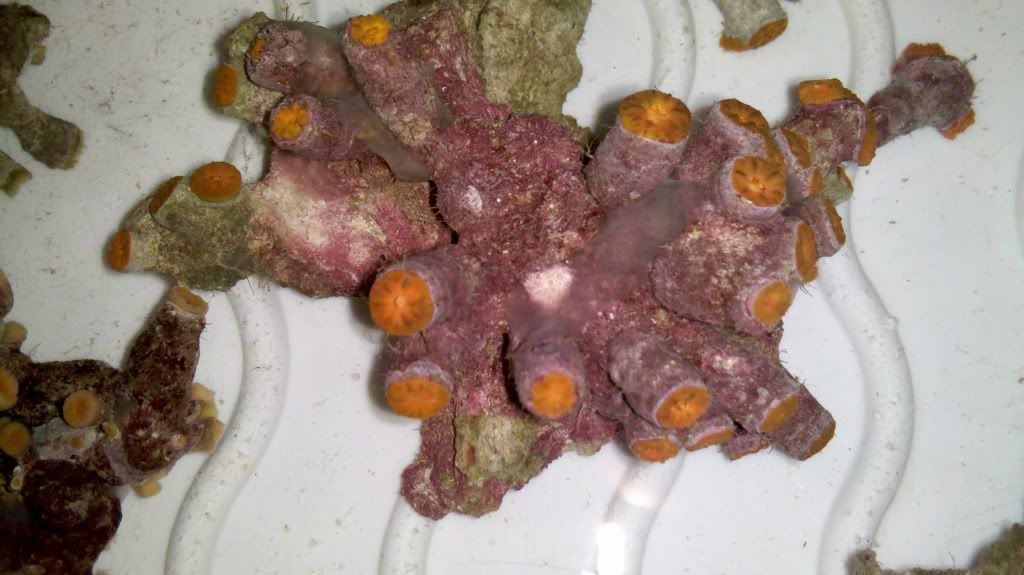 |
| A badly compromised Tubastrea colony. Note the sponge growing between the corallites. The author has begun an attempt to coax this and a number of other colonies back from the brink. |
Biological Basics
Like all the corals we keep, the various species of Tubastrea are in the phylum Cnidaria and they share the basic characters of that group including radial symmetry, a ring of stinging tentacles and a single gut opening. Many species of Cnidarians live as solitary polyps while many others live in colonies with all species of Tubastrea falling into the latter category. Most species have stout, chunky corallites about 1/2 inch across. One yellow species has smaller corallites about half that size and the corallites of the Black Sun Coral are in between the two, about 1/3 of an inch across. In hobbyist terms, Tubastrea are LPS or Large Polyp Stony corals. All the yellow and orange species have the same basic growth habit of an expanding mound and colonies of 3 to 5 inches across with 15-40 polyps are the size commonly available to most aquarists. The Black Sun Coral has a branching, vertical habit and colonies may grow to more than 3 feet tall. In addition to its different growth habit, the Black Sun Coral, Tubastrea micrantha, has some amount of endolithic algae living in its skeleton which may provide a measure of nutrition but in no way changes their need for a continuous supply of delicious zooplankton or, in the case of captive colonies, at least daily feedings.
Common species of Tubastrea include Tubastrea coccinea, Tubastrea aurea, Tubastrea micrantha, Tubastrea diaphena, and Tubastrea faulkneri. Their range varies by species and in some places, Sun Corals have actually become invasive. Both Tubastrea coccinea and Tubastrea micrantha are the sole colonizers of oil rigs off the Louisiana coast and in areas there and down into the gulf, both species can be considered invasive. A bit ironic considering the difficulties associated with their captive care.
Captive Care
As mentioned, Tubastrea species lack symbiotic zooxanthellae and are entirely dependent on meaty foods for their survival. As such, they don't need the light levels most corals need and have found their major niche in relative darkness on the ceilings of caves and overhangs in areas of high flow. They require this high flow to bring them their daily dose of zooplankton. Some aquarists follow this natural lead and affix their colonies to rocky ceilings out of direct light. This can be a cool effect and, if flow to the area is good and feeding of the tank is heavy, Tubastrea may require less direct feedings in this position. Further, algae is less likely to colonize any exposed skeleton if the colony is kept out of the light the algae needs to survive. In spite of all this, Tubastrea can not only withstand all types of reef lighting, they can thrive in it. Wherever you put your Sun Corals, it's about food and flow, not about light, so I suggest putting colonies where you can see them well and where they're easy to feed. Of course you want to keep them away from other stinging animals, though colonies of different color morphs and species may be kept touching each other without damage.
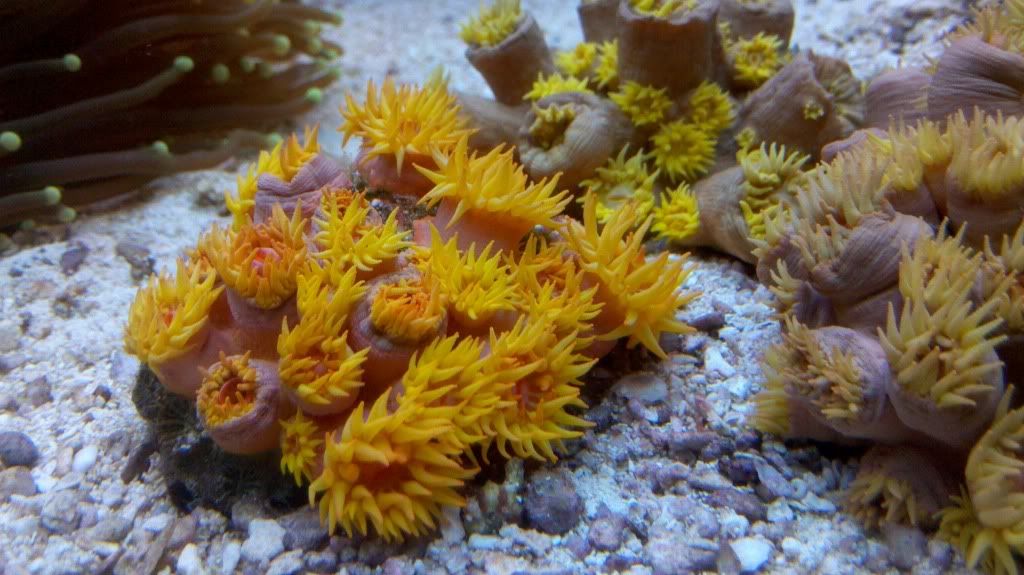 |
| Three small Tubastrea colonies kept in a group in the author's aquarium. The visual impact is greater when the colonies are massed together. |
Other than their "Feed me, Seymour!" way of looking at life, Sun Corals have the same basic requirements as the other corals we keep in terms of water quality, salinity, temperature, PH, etc. Moderate flow by reef keeper standards is appropriate as too much flow may damage the fleshy tissue. "High flow" in nature is much different than the high flow we provide the animals in our tanks. Enough flow to keep the colonies free of detritus and, if possible, carry suspended food to them is perfect. I prefer to display colonies on the sandbed but they may be affixed to rock work by standard means.
Feeding
It should be abundantly clear by now that effective feeding is the key to success with Sun Corals. Though target feeding is the most common approach, it is possible to feed Tubastrea indirectly by creating a sufficient density of food in the water column and sufficient flow to keep it suspended long enough for the coral to extend its polyps and capture the food. The density of foods required for this style of feeding is extremely high, putting water quality in significant jeopardy. Some aquarists account for this by moving their colonies into a separate tank for feeding and then back into their display. I've been using this method with the badly compromised colonies I've been charged with.
I place the colonies into a tub of water from their holding tanks and add several airstones for water movement. I then introduce copious quantities of cyclopeeze and prawn roe as well as the occasional treat of live Artemia nauplii. The corals are left in this food-rich environment for about 1 hour with care taken not to let the water temperature fall too far. This feeding is done 4-5 times weekly (that's as much time as I'm able to spend at the facility where they're being kept.) After 4 weeks, some improvement in color and some polyp extension can be seen but the road ahead for these animals remains a long and difficult one with an uncertain end.
In my experience, the easiest way to feed healthy Tubastrea colonies is to target feed the individual polyps with the aquarist's tool of choice. I used to use a turkey baster but food would tend to trickle out even if I wasn't putting pressure on the bulb so I've moved to the daintier pipette. It can be more difficult to suck up the mysis with but its delivery is more controlled. And when you're feeding this much food, you don't want to be wasting any. I take a chunk of frozen mysis and thaw it in water for about 10 minutes. I then drizzle this water into the tank in the vicinity of the coral. This typically triggers polyp extension in about 5 to 10 minutes. In nature, these animals are primarily nocturnal feeders and thus often have closed polyps during the day which gives rise to the need for this procedure. With daily feedings during lights-on, most aquarists find their colonies will adapt and begin to produce polyp extension during the day. Once the polyps are out, its a fairly simple if laborious process to deliver one mysis to each polyp. After feeding, polyps will be noticeably plump as the food is digested. Undigested food will be regurgitated.
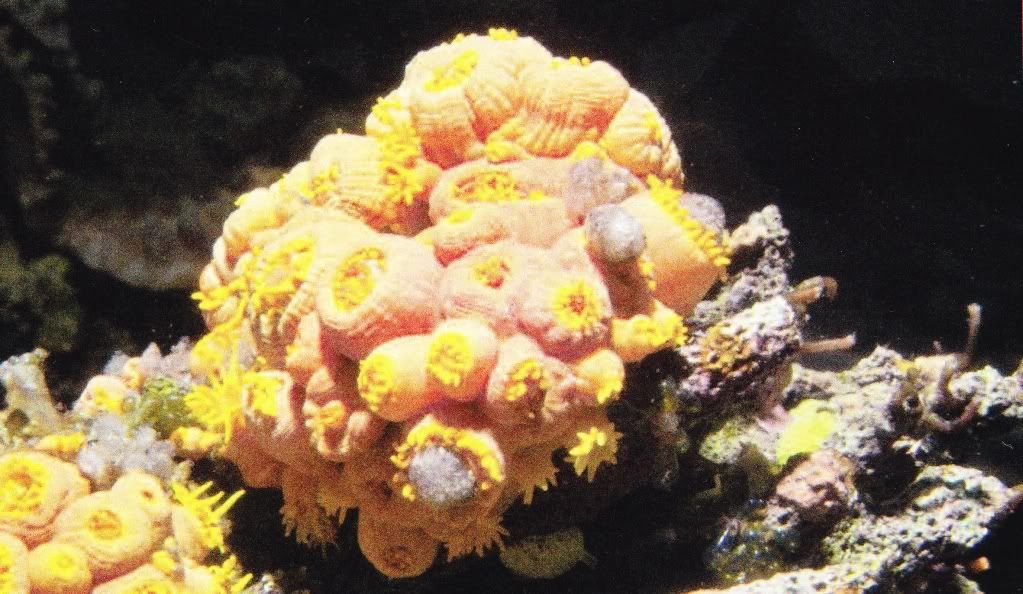 |
| A fat and happy Tubastrea colony chucking up undigested mysis in the "Tubastrea Garden" of German aquarist Daniela Stettler. Photo by Daniel Knop and published in Coral Magazine, Volume 3, Number 4. |
Thriving colonies of Sun Coral not only grow, producing new corallites as they do, but may also reproduce sexually, releasing planular larvae which can settle and grow into new colonies. One of the most famous examples of this is the so-call "Tubastrea Garden" of German aquarist, Daniela Stettler and presented in an article by her published in Coral Magazine, Volume 3, Number 4. Here she describes her methods of feeding as well as capturing the larvae (so as to keep them from becoming fish food) and encouraging them to settle on introduced substrate. She found that good flow was key to settlement and survival which corresponds to Tubastrea's flow-rich niche in the wild.
 |
| German aquarist Daniela Stettler target feeding her "Tubastrea Garden". She doesn't look too upset about it. Photo by Daniel Knop and published in Coral Magazine, Volume 3, Number 4. |
German aquarist, author and publisher, Daniel Knop, suggests that daily feeding of every polyp is necessary for colonies to have the extra energy necessary to produce gametes. In my experience, a slightly less intense schedule can still be effective. I typically fed the colonies in my aquarium at least every other day. Again, feeding every single polyp at least one mysis shrimp. With this schedule, I was able to get the production of larvae and successful settlement of the occasional animal. I removed my colonies over a year ago upon introduction of my first pair of Oxymonacanthus longirostris, a coral eater. Nevertheless, just weeks ago, I found several polyps growing under an overhang in my tank and appearing quite healthy. I was suprised and delighted.
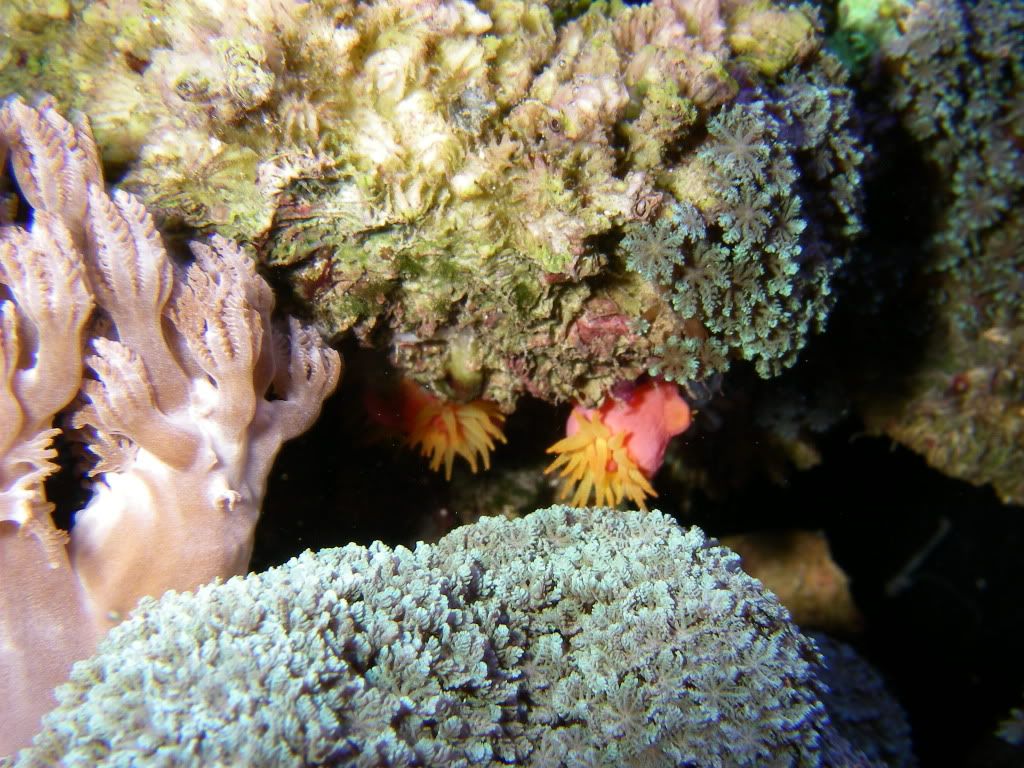 |
| Pioneering polyps of this Sun Coral were discovered well over a year after the mother colony was removed from the author's aquarium. |
With time and dedication, Daniela Stettler's amazing tank is a testament to what can be achieved with Sun Corals.
 |
| Another view of the "Tubastrea Garden" of Daniel Stettler. Photo by Daniel Knop and published in Coral Magazine, Volume 3, Number 4. |
The Black Sun Coral is thought to require even more care than its yellow cousins and reports of success with it are comparatively rare. I have been target feeding the two colonies in my care 4-5 times weekly with mysis and they seem to be holding their own after 4 weeks. More time will reveal the relative efficacy of my methods. Ideally, colonies of Tubastrea micrantha would be fed multiple times daily. It is wise with any Sun Coral to error on the side of caution and, if anything, over feed.
Feeding Tubastrea micrantha in a semi-open system like this one allows for very heavy feeding without compromising water quality.
With all Sun Corals, food robbers can be an issue. Whether it's hungry fish or invertebrates, it's common for other animals to come and take food right off of the tentacles of your Tubastrea colony. Some aquarists will combat this by putting an inverted plastic bowl or other cover over their colonies immediately after feeding so that their corals can ingest and digest in peace. My method was to feed the fish heavily first, then feed the Tubastrea. This worked pretty well but my Peppermint Shrimp were always sneaking a few pieces of mysis anyway. This issue is another to consider before you embark on your Tubastrea odyssey.
Summary
Though the various species of Sun Coral are some of the most dazzling colorful and fun to feed corals we may keep in aquaria, they are not for the faint of heart of busy of schedule. Target feeding as well as maintaining high water quality in the face of copious feedings are the two main challenges and they are challenges which can definitely be met by dedicated aquarists who fancy a challenge.
Sources
The information in this article comes primarily from personal experience as well as anecdotal information gleaned from internet forums and other online sources. Additionally, "Propagating Stony Corals in Your Own Living Room" by Daniela Stettler and published in Coral, Volume 3, Number 4 was a major source of information and inspiration. The World Register of Marine Species website was also a source as was this article from Jake Adams of Reef Builders.
Update:
We have babies! And black ones at that. Yes, the two colonies of black Tubastrea have produced planulae which have settled and are visibly growing. I'm trying to feed them Cyclopeeze along with the other small-polyped colonies. This is quite exciting. As mentioned, the black form of Sun Coral is often considered the most demanding and to have reproduction is a bit of a deal. Wheee!
-paul
Sources
The information in this article comes primarily from personal experience as well as anecdotal information gleaned from internet forums and other online sources. Additionally, "Propagating Stony Corals in Your Own Living Room" by Daniela Stettler and published in Coral, Volume 3, Number 4 was a major source of information and inspiration. The World Register of Marine Species website was also a source as was this article from Jake Adams of Reef Builders.
Update:
We have babies! And black ones at that. Yes, the two colonies of black Tubastrea have produced planulae which have settled and are visibly growing. I'm trying to feed them Cyclopeeze along with the other small-polyped colonies. This is quite exciting. As mentioned, the black form of Sun Coral is often considered the most demanding and to have reproduction is a bit of a deal. Wheee!
All Tubastrea colonies continue to be fed 4-5
times weekly to satiation with a mix of Hikari Mysis and Cyclopeeze brand
copepods.
